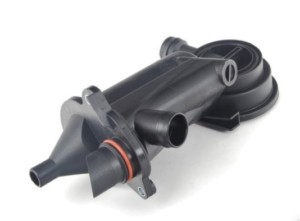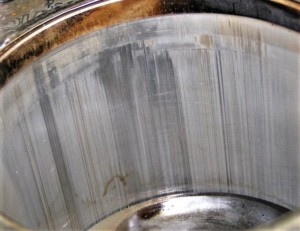Porsche Cayman Common Problems
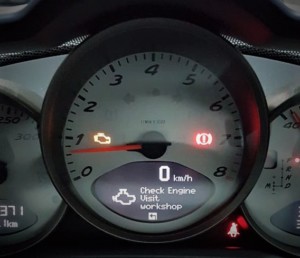 What are the most common reliability or mechanical problems diagnosed on the Porsche Cayman?
What are the most common reliability or mechanical problems diagnosed on the Porsche Cayman?
Listed below are Porsche Cayman common mechanical problems with their likely resolutions. These are the most frequent Cayman problems diagnosed by our repair shops over the years.
An accurate diagnosis of an issue by a Porsche mechanic typically saves you time and money – see our guide to local independent Porsche repair shops that can help. If you’re researching and considering buying a Porsche Cayman, our used car buyer guides highlight mechanical issues to be aware of before you complete a purchase.
Dashboard Warning Lights?
Scanned the car and not sure what to make of those OBD codes? Our article on how to interpret and make sense of those fault codes may help.
Could Maintenance Solve a Porsche Cayman Problem?
Maintenance rarely solves a problem. However, neglecting maintenance can cause issues – check your last service update with our recommended maintenance schedules.
Check Engine Light? Scanned Your Cayman and Read Diagnostic Codes?
The following sections identify common problems through symptoms. If you have scanned your Porsche Cayman OBD2 system and have identified fault codes, go to our Porsche powertrain fault code page to get fault descriptions.
Can’t Find An Answer Below? – Contact Us For More Help
If your Cayman has mechanical issues that don’t appear here, simply drop us an email via the forms or pop-up contact and we’ll do our best to share a solution with you.
Clicking on each heading will give you more detail.
Porsche Cayman Common Problems by Symptom – 987 | 981 | 718
Oil Leak - Rear Main Seal
Symptom: Oil Leaking Between Engine & Transmission
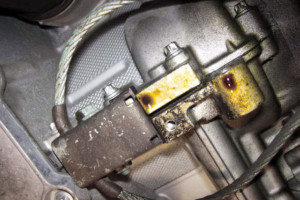
One of the most common, misunderstood and potentially destructive issues on the Cayman, is an oil leak from the rear main seal. A leaking rear main seal appears through the bell housing joint between the center of the engine and transmission joint. The leaking seal will quickly destroy a clutch in a manual car if not addressed promptly and can be a sign of other issues.
Some caution – vehicles that are stored often display a weep/leak from the seal during storage or at the initial startup in the spring. The seal needs the heat of driving to remain sealed efficiently, so in some circumstances the leak can slowdown or stop during the driving season. Replacing the seal requires the removal of the transmission and in a manual car, replacement of the clutch at the same time is a good choice.
The seal does dry over time and can leak, however, there are other potential issues that could also cause the seal to leak (see Air Oil Separator below). Causes of the seal failure should be checked thoroughly by a specialist shop before you proceed to replace the seal.
Smoke on Start Up of Cold Engine
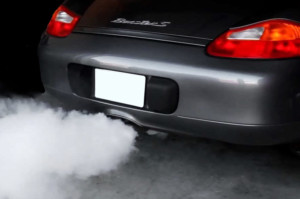
A quick puff of smoke as you start a cold engine is not uncommon, especially on the Porsche flat six engine in the Cayman. There are many theories and various thoughts as to why this happens – none are proven. What is known, is that re-built engines rarely display this startup smoke, so it’s definitely a sign of wear and tear – and it does progressively get worse with mileage. Vehicles that have sat for a while, such as winter storage for example, often blow more smoke at their first start rather than subsequent ones.
Extended smoking at startup is more of an issue. Again, there could be a number of reasons why this happens, but it is usually a sign of wear in the cylinders. See cylinder scoring below.
Sometimes, replacing the fuel injectors can help this problem. Worn and leaking fuel injectors cause fuel to sit in the intake path while the car is parked. The fuel leaking is not enough to cause starting problems, but it can be responsible for the smoke and wear in the cylinders – the excessive fuel heading into the cylinders washes oil off the cylinder walls causing wear on the piston rings and liners. The burning oil / fuel mixture makes more smoke.
The smoke at startup can also be caused by a bad air oil separator (AOS) that has not completely failed yet.
Likely Oil Leaks
The Porsche Cayman has a number of common sources for leaking oil. Some of the most common include rear main seal (see below), valve covers, spark plug seals and oil cooler seals. Less common are leaks from the cam seals and scavenger oil pump seal.
Symptom: Oil Drips on Floor Below Engine
 Valve cover leaks are obvious and fairly straightforward to fix on most models. The valve covers do not have a gasket – instead a liquid gasket sealer is used. The time consuming part is removing the old gasket sealer from the valve cover to ensure a good seal for the replacement. Valve cover leaks can make their way onto the exhaust headers and lead to a burning smell or worse.
Valve cover leaks are obvious and fairly straightforward to fix on most models. The valve covers do not have a gasket – instead a liquid gasket sealer is used. The time consuming part is removing the old gasket sealer from the valve cover to ensure a good seal for the replacement. Valve cover leaks can make their way onto the exhaust headers and lead to a burning smell or worse.
Symptom : Misfires CEL or Oily Spark Plugs
Spark plug tube seals are also prone to leaking – leaks from the spark plug tube seals can be frustrating. Often, you wont see the oil initially, as it’s sealed in by the coil on top of the spark plug. The tube fills with oil and causes misfires by destroying the plug and the coil. If you see oil on a plug or coil, always replace the seals.
The upper seal can be replaced when removing the valve cover. The lower seal leaking is less common but more of an issue and requires removal of the camshafts.
Air Oil Separator (AOS)
Symptoms : Smoke From Exhaust, Oil In Intake, Rear Main Seal Leak
Leaking rear main seal or something else causing the problem?
An integral part of the emissions system, the Air Oil Separator (AOS) is designed to extract oil from gases in the crankcase. The oil is recycled to the sump, while the gas is passed through the combustion path to be burnt and cleaned by the catalytic converters. The AOS has caused numerous issues on Porsche engines and is an item to be closely monitored.
As the membrane in the AOS fails, oil is sucked into the air intake. Initially this can show up as a check engine light for fuel adaptations with oil being deposited on the o2 sensors causing emission faults.
Of course, once it fails completely, the resultant burning oil produces huge clouds of white smoke – this is fairly obvious. At that point, it is clear what needs to be done. However, replacing the AOS sooner rather than later can be a good precaution against other failures.
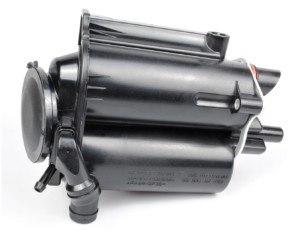 A failing air oil separator (aos) is the likely cause of rear main seal failure and oil leaks, as it is in other VAG cars. Crankcase vacuum exceeds the normal range in the engine under heavy acceleration and sucks in air damaging the rear main seal. This is commonly seen on Audi engines as well.
A failing air oil separator (aos) is the likely cause of rear main seal failure and oil leaks, as it is in other VAG cars. Crankcase vacuum exceeds the normal range in the engine under heavy acceleration and sucks in air damaging the rear main seal. This is commonly seen on Audi engines as well.
A failing AOS also causes too much oil to pass into the intake and will force the engine management to adjust fuel mixtures to compensate. The changing mixture can cause over fueling and lead to other more significant problems – See smoke at startup above.
For cars that go to the track on a regular basis, a Porsche Motorsport AOS upgrade is highly recommended. The upgraded AOS features a doubling in size of capacity for scavenging and is less prone to sucking up oil during high speed cornering.
IMS Bearing - Hype vs Facts
Symptoms: Metal Shavings In Oil
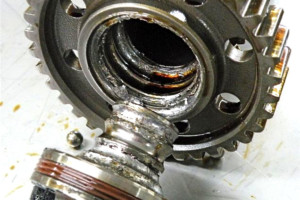 The early M97 engines fitted to the 987 Cayman can have issues with a bearing at one end of the engine intermediate shaft. The shaft connects the two ends of the engine timing gear. At one end, the shaft drives the oil pump and at the other, finishes in a sealed bearing.
The early M97 engines fitted to the 987 Cayman can have issues with a bearing at one end of the engine intermediate shaft. The shaft connects the two ends of the engine timing gear. At one end, the shaft drives the oil pump and at the other, finishes in a sealed bearing.
There’s no doubt that a cheap sealed bearing of the kind that sits at the end of the intermediate shaft on an M97, has no place in a performance engine. Porsche subsequently redesigned the engine to eliminate an IMS bearing after clearly identifying its potential for weakness.
However, the hype generated by people who have to gain from identifying the problem with this bearing and the real world results don’t quite match.
Yes, be clear, the IMS bearing is a weak point and it will fail. However, in the real world less than 5% have actually failed or can be directly linked to an engine failure. Porsche shipped approx. 77,000 vehicles to the USA that could have a bad IMS bearing. Even the most enthusiastic counting of IMS failures produces a total around 3500 or less than 5%. This means there are more than 73,000 vehicles out there that haven’t had the problem yet or have been retrofit with a newer bearing. Of course, that number excludes the cars driven into a ditch, wrapped around a lamp post, rolled off a cliff or set fire too, but you get the point. There are significantly more good M97 engines than bad ones.
Most competent shops will recommend replacing the bearing, at least as a safe guard against a future failure. Once the bearing has been retrofit, the value in the car is enhanced versus a vehicle that still has the original bearing.
Check Engine Light & Misfires - Engine Runs Rough
Symptoms : Engine Runs Rough or Lacks Power – Flashing CEL
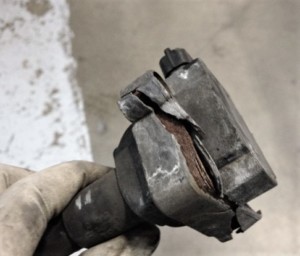 Misfires can occur at any time on the Cayman engine and require diagnosis to identify which cylinders are misfiring and why. Common causes are worn spark plugs, cracks in ignition coils and oil leaking past the spark plug tube seals (see above).
Misfires can occur at any time on the Cayman engine and require diagnosis to identify which cylinders are misfiring and why. Common causes are worn spark plugs, cracks in ignition coils and oil leaking past the spark plug tube seals (see above).
The ignition coils on the M97 Cayman engines have been updated by Porsche multiple times. The original coils were prone to cracking and were replaced by a more substantial version. Low mileage older cars will commonly still have the older style coils and it’s best practice to replace them all to the newer version, even if only a single coil has failed.
Fuel injector malfunction can cause a misfire, however injector failure of this nature is not so common on the Porsche flat 6 engines. More commonly, a failure in the wire or plug connected to the injector can cause a weak of misfiring cylinder. These wires and connectors can become brittle and crack, especially when being moved around for routine maintenance. Check the wiring thoroughly before replacing injectors.
Check Engine Light - Engine Runs Well
Symptoms: Check Engine Light, Engine Runs Well, No Loss of Power
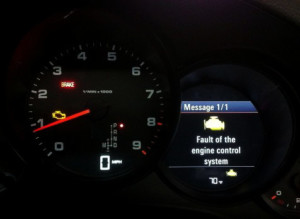
There are many potential causes of a Check Engine Light on the Porsche Cayman and it’s important to read the engine codes or have a repair shop do that for you to assess the faults. Typically, an engine that sets faults yet runs well, suggests problems related to emissions control.
One of the most common causes for a CEL on the older M97 engine in the Cayman is a failure reported in the O2 sensor and mass airflow systems (MAF). Commonly, the MAF begins to fail and delivers the engine management with inaccurate information regarding the flow of air into the intake.
This causes the engine management to adjust fuel mixtures using a set of parameters which were likely set too broadly by Porsche initially. The resultant adjustments cause the front O2 sensors to report faults and often lead to them failing completely. The fault codes will suggest faulty O2 sensors. This results in many folks just replacing the front O2 sensors in the hopes of solving the problem, only to discover that within a few hundred miles, the check engine light is back on.
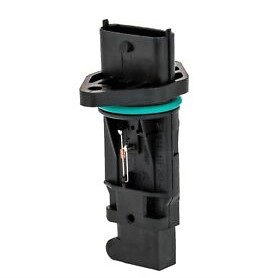 The problem can also be set in a number of ways. The faults are an indication of the symptoms and not the route cause. In many cases, this could also point to a faulty MAF, but it is common for the Cayman to experience a vacuum leak through a cracked intake or vacuum hose that looks like a MAF failure. Un-metered air entering the intake system causes the engine to run lean, with engine management adding fuel to compensate until no longer possible.
The problem can also be set in a number of ways. The faults are an indication of the symptoms and not the route cause. In many cases, this could also point to a faulty MAF, but it is common for the Cayman to experience a vacuum leak through a cracked intake or vacuum hose that looks like a MAF failure. Un-metered air entering the intake system causes the engine to run lean, with engine management adding fuel to compensate until no longer possible.
Finding a small leak in the intake system can be difficult – the best way is using an EVAP smoke machine and a specialized repair shop!
CEL and Misfire at Higher RPM Only
Symptoms: Engine Runs Well Up To 4K RPM then Misfires
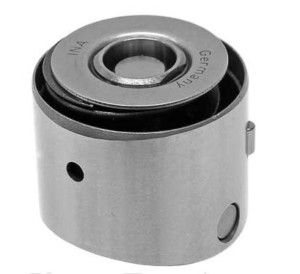 This is a problem that many so-called experts will tell you doesn’t exist. However, we have diagnosed and fixed this issue on a number of Cayman engines.
This is a problem that many so-called experts will tell you doesn’t exist. However, we have diagnosed and fixed this issue on a number of Cayman engines.
If you have the issues, you find the engine runs perfectly below 3K rpm. Revving the engine above 4K rpm causes a misfire to be reported on a single cylinder and engine management shuts off the cylinder. Consequently, below 3K rpm the engine now runs rough until the fault is cleared. Once the fault is cleared the engine runs perfectly again below 4K until the fault is triggered again.
Typically, this happens to a single cylinder repeatedly. Initially, this sounds like a failing spark plug, injector or coil and can indeed be solved by replacing them, if you’re lucky. However, if you have replaced both the coil and the plug and still have the same problem, there is another solution.
The Porsche flat 6 engine has a two-stage intake lifter that fails. As you accelerate the engine rpm, the lifter expands to increase valve lift. The lifter commonly breaks and during the second stage of valve lift, which occurs above 4k rpm, it does not function correctly – this results in a misfire on a single cylinder. The engine management then shuts off the cylinder until the fault is cleared.
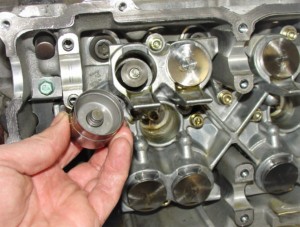 This problem can be solved by replacing the lifters on the particular cylinder on which the fault occurs – although replacing all the lifters on that particular bank, whilst expensive, is probably the recommended solution. If left alone, the lifter can stick causing a permanent misfire or worse.
This problem can be solved by replacing the lifters on the particular cylinder on which the fault occurs – although replacing all the lifters on that particular bank, whilst expensive, is probably the recommended solution. If left alone, the lifter can stick causing a permanent misfire or worse.
In a couple of customer cases that we’ve seen, the stuck lifter went on to break the intake camshaft destroying the bearings in the valve cover. We also experienced an M97 engine where the lifter had been ejected out of the valve cover, leaving a nicely sized hole and very oily mess. In both these cases the engines were repaired and functioned perfectly afterwards.
Replacing lifters requires specialized skills and timing knowledge – we recommend you seek the help of an independent repair shop.
CEL - Cam Solenoid Failure
Symptoms: Check Engine Light and Lack of Power
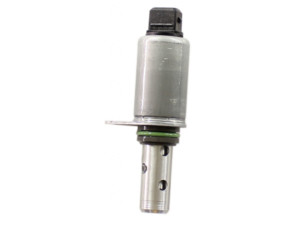
The M97 engines found in the Cayman have variable valve lift and timing. Part of the variance is controlled by the cam solenoids located in the valve covers. The cam solenoid is an electro-mechnical device that redirects oil pressure as per the demands of engine management. The increase in oil pressure enables camshaft timing adjustment.
Problems with these solenoids are often the cause of a CEL and a lack of power under acceleration. Scanning the engine management system should provide codes which identify the solenoids that are failing and replacing them usually solves the problem. Porsche released updated versions of the cam solenoids during the production period.
Some of the cam solenoids can be replaced without the removal of the valve cover; however, others do require the valve cover removal and are more intense work. We recommend inspection of the wiring to the solenoids before replacing them – these can become corroded on older cars due to their location.
Cylinder Scoring - Engine Knocking Noise
Symptoms: Engine Knocking Noise, Oil Consumption, Black Exhaust Tail Pipe
The M97 engines found in the Cayman are famed for cylinder scoring – deep gauges in the cylinder liner, usually associated with a knocking noise and eventually catastrophic engine failure. The root cause of this issue is open to discussion, however, wear in the piston rings and liners causes the piston to wobble. The wobble occurs at the bottom of the stroke and results in the piston skirt dragging against the cylinder wall, thereby scoring the liner.
More recently, this issue has also been seen on the later 9Ax engines. An early telltale sign can be one exhaust tailpipe being more sooty black than the other. This is a clear sign of a difference in fuel mixtures and oil burning on one cylinder bank versus the other.
The sound of this problem is not a tick like a bad lifter, it’s more a rhythmic knock and usually shows up first on the passenger bank of the flat 6 engines. Wear in the piston rings and the liners of the cylinder have caused the piston to wobble. The wobble occurs at the bottom of the stroke and causes the piston skirt to drag against the cylinder wall, causing scoring of the liner. The rhythmic knock is the piston changing position at the bottom of the stroke and hitting the liner. In many cases, even with the head off the engine, the worst scoring cannot be seen until the piston is removed – it can be way down at the bottom of the cylinder.
The only solution here is a replacement engine or rebuild and re-lining of the cylinders. A competent Porsche repair shop can help you through this process.
PDK Issues - Transmission Failure
Symptoms: PDK Failure Light, Rough Gear Changes, Transmission Faults, Emergency Transmission Run Warning on Dash
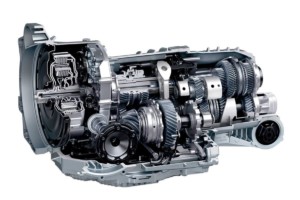 The Porsche-Doppelkupplungsgetriebe – which translates to Porsche double-clutch transmission or PDK – now that’s when you really need an acronym! A number of Porsche Cayman owners have experienced failure of the PDK transmission.
The Porsche-Doppelkupplungsgetriebe – which translates to Porsche double-clutch transmission or PDK – now that’s when you really need an acronym! A number of Porsche Cayman owners have experienced failure of the PDK transmission.
The PDK is an automated manual transmission. Two units matched together – a manual transmission rear section and automated dual clutch front section. The manual transmission rear section is very solid and reliable. Most issues occur with the electronic and hydraulically controlled clutch section at the front of the transmission. Physically, the PDK is a ZF transmission unit that has been around for a number of years. VAG took multiple versions of the transmission and personalized them for their various car ranges. Porsche adapted the software and labeled their version PDK.
There are a number of ways in which the PDK in the Cayman can fail. Most show up as a collection of warning lights on the dash and an eventual refusal to do anything. The only viable solution for most people is the replace the PDK – this is very expensive. However, much of the need for replacement of the PDK comes from a lack of understanding, unavailable parts and an unwillingness to dig deep.
Components and Failures
Transmission Control Module – TCM
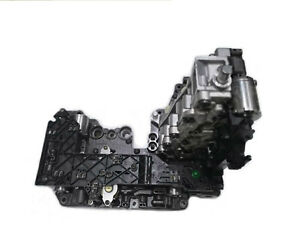 The connection to the car and communication of instructions to the transmission, come from an external module called a transmission Control Module (TCM). While this rarely has issues, it can become confused and has been the subject of a number of software revisions. Re-flashing the TCM doesn’t usually solve problems, but ensuring you have the latest software revision can’t hurt. This is where diagnostic faults are stored.
The connection to the car and communication of instructions to the transmission, come from an external module called a transmission Control Module (TCM). While this rarely has issues, it can become confused and has been the subject of a number of software revisions. Re-flashing the TCM doesn’t usually solve problems, but ensuring you have the latest software revision can’t hurt. This is where diagnostic faults are stored.
Mechatronic Unit – Valve Body
The TCM sends instruction to the Mechatronic unit or valve body inside the transmission. The Mechatronic unit is a complex series of electronics, hydraulic valves and sensors. These devices are managed by a control module attached to the Mechatronic unit. This is the system which enables gear changes and controls the transmission functionality.
The Mechatronic unit is a common failure point for this type of transmission. In 2009, VW recalled 53000 of them – so there have been many issues in the past. Problems with the Mechatronic unit vary, but commonly include failure to select gears, rough gears changes, etc. The physical components of the transmission are robust, so this unit is often the most economical place to start for most issues.
Sensors
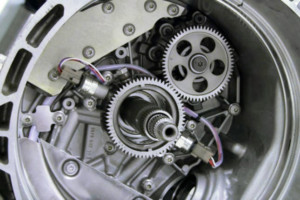 Connected to the Mechatronic unit are a number of sensors throughout the transmission. These determine the operating conditions within the transmission. For example, the temperature of the fluid, the rotational output speed, hydraulic clutch pressure and movement of gears selectors. Failure of these sensors is very common. Early on, Porsche routinely replaced the wiring and trans temp sensor in most of the PDKs.
Connected to the Mechatronic unit are a number of sensors throughout the transmission. These determine the operating conditions within the transmission. For example, the temperature of the fluid, the rotational output speed, hydraulic clutch pressure and movement of gears selectors. Failure of these sensors is very common. Early on, Porsche routinely replaced the wiring and trans temp sensor in most of the PDKs.
However, the problem did not go away and has re-occurred on the same transmissions further down the road. The temp sensor problem can show up on almost any model with a PDK.
Clutch
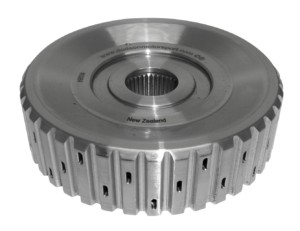 The clutch pack has proven to be very robust and generally does not fail with normal use. Over extended mileage this will become a wear component that will need to be replaced. The failures of the clutch that have occurred, are usually on performance enhanced engines delivering too much torque for the clutch plates. At higher torques, the clutches slip resulting in highly accelerated wear and early failure.
The clutch pack has proven to be very robust and generally does not fail with normal use. Over extended mileage this will become a wear component that will need to be replaced. The failures of the clutch that have occurred, are usually on performance enhanced engines delivering too much torque for the clutch plates. At higher torques, the clutches slip resulting in highly accelerated wear and early failure.
Why do I need to replace the PDK?
The PDK transmissions in the later cars are very complex and the technology involved is a closely guarded secret. Technicians at Porsche are not trained to dissect the transmission and make repairs. They will replace the Mechatronic unit, but often they just replace the transmission as a whole. The components such as the Transmission Control Module (TCM) and the Mechatronic Unit or valve body inside the transmission are often unavailable as parts outside of the Porsche workshop.
The manufacturers do not want it taken apart and it’s often described as a “sealed PDK”. The result from faults is often a new PDK, when in reality, an internal component swap would likely save the whole unit from being replaced. While there is a lot of complex “stuff” in there, the physical components typically don’t break. So, being forced to lash out $12K to $15K for a new PDK, in our mind, is often caused by an unwillingness of people to take the thing apart!
Can You Get Creative?
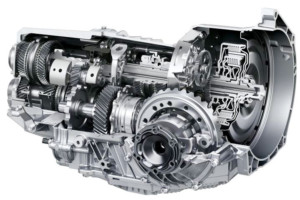 Creative can often translate to money saving. Removal and disassembly of the PDK is not complex. However, access to parts and the need for a PIWIS to re-initialize the PDK are barriers for the DIY enthusiast. There is an excellent article here that provides good background, examples of the work and videos of the internals of the transmission.
Creative can often translate to money saving. Removal and disassembly of the PDK is not complex. However, access to parts and the need for a PIWIS to re-initialize the PDK are barriers for the DIY enthusiast. There is an excellent article here that provides good background, examples of the work and videos of the internals of the transmission.
Having experienced a PDK problem on a vehicle we owned, we got creative. Based on issues with other transmissions, such as the Mercedes Benz, commonly known for valve body failure, we were convinced our issues lay in the physical part of the Mechatronic unit. Short version – we got a new Mechatronic unit from Audi, replaced the electronics with the original unit from the Porsche, flashed the TCM to match new software levels and hey presto, a perfectly working PDK!
If you have PDK problems and want to try something creative before shelling out for a new unit, you’ll need the help of an expert independent Porsche repair shop.
Low or No Battery Power - No Crank
Symptoms: No Crank, Slow Crank or No Power
 The Porsche Cayman is often a garage queen and not driven as much as many other cars – rarely are they daily drivers. During any down period the Cayman will continue to use some battery power – in Porsche’s case, usually more than would be expected from similar vehicles. This can very quickly lead to a flat battery.
The Porsche Cayman is often a garage queen and not driven as much as many other cars – rarely are they daily drivers. During any down period the Cayman will continue to use some battery power – in Porsche’s case, usually more than would be expected from similar vehicles. This can very quickly lead to a flat battery.
Losing battery power resets a number of important systems and can cause unnecessary headaches with everything from emissions to electronics. We recommend you use a battery maintainer any time you store or do not drive the car for an extended period – 2 weeks or more. Leaving the battery to drain completely usually shortens the life of the battery as well.
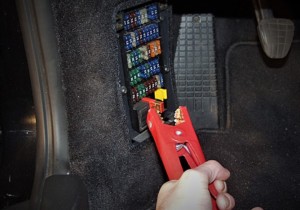 A flat battery on a Cayman can be a pain. To access the battery or engine compartment requires battery power for the electric hood release – not easy with a flat battery. If this happens, use the following procedure:
A flat battery on a Cayman can be a pain. To access the battery or engine compartment requires battery power for the electric hood release – not easy with a flat battery. If this happens, use the following procedure:
- Open the left door
- Connect an external battery power source to fuse C3 in the interior fuse panel
- With the door open, flip the door latch mechanism to the closed position
- Use the key to lock and unlock the door
- The front hood release should now function
Oil in the Coolant Reservoir
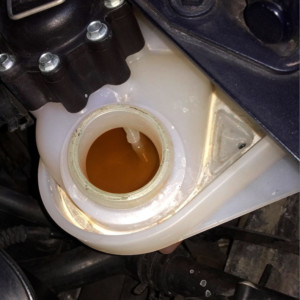
Symptoms: Oil Residue in Coolant Reservoir
Oil mixed in the coolant can quickly look like peanut butter in the coolant reservoir. This typically starts out as an oily film and continues to get worse over time. There are many potential problems associated with this sign – oil could be getting in to the coolant from a blown head gasket, from a crack in the cylinder head, a crack in a cylinder liner or through the oil cooler. For sure, coolant in the oil and visa versa is a bad sign, the question is how lucky will you be as to where the problem is? Diagnosing the problem often requires multiple steps.
The simplest place to start is by replacing the oil cooler – this is the easiest and least expensive item to tick off the list of possible problems. Generally the likely issue is caused by the coolant and oil swapping places through the oil cooler.
Assuming the the oil cooler is the issue, it sits beneath the intake and is exchanging heat between oil and coolant at a barrier level. When the barrier separating the two fluids inside the cooler breaks down, fluid can be exchanged – sometimes in both directions. The result is oil in the coolant and worse, coolant in the oil. Coolant in the oil is a quick way to needing a new engine, so it’s critical to diagnose this problem asap.
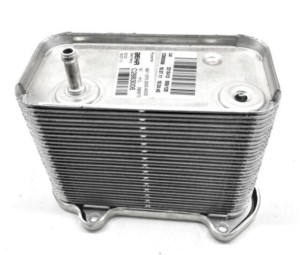 If after replacing the cooler, you need to go to the next stage, having a new oil cooler is not the end of the world and at least eliminates the cooler as the source immediately.
If after replacing the cooler, you need to go to the next stage, having a new oil cooler is not the end of the world and at least eliminates the cooler as the source immediately.
If replacing the cooler does not solve the problem, the remaining options are expensive and likely require major engine surgery. This is where a specialized repair shop can help to quickly and cost effectively get to the route cause of the issue.
Coolant Leaks - Water Pump Failure - Radiator Leaks - Front Coolant Pipe
Symptoms: Low or Flashing Coolant Light – Coolant Leak
In general, the Porsche Cayman has a pretty reliable cooling system. There are however, a number of weaker areas that can sometimes cause issues.
Coolant Reservoir Leaks
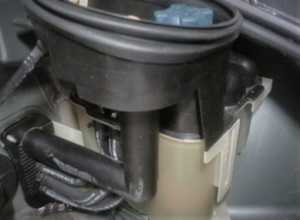
One of the most frustrating leaks is a small crack in the coolant reservoir. This happens on all models and usually shows up as a coolant smell while driving with minor loss of coolant over a period of time. Eventually a minor crack will split wide open and empty the reservoir rapidly – this is to be avoided if at all possible. Replacing the reservoirs on Cayman is not expensive but can be a pain.
You should never loose coolant while driving – so if your coolant level does decline over time, find the cause and solve it asap. Under worst circumstances this could be a sign of a cracked cylinder liner.
Radiators

On the Cayman, the radiators are low down and exposed to incoming road debris. Small holes in the radiator can be difficult to see without removing the front bumper and searching for the telltale white coolant stain. Often the holes are not caused by debris hitting the radiator but are due to deterioration of the seals in the corners of the radiators.
Leaf and road debris is not easily cleaned out from the depths below the bumper and can hold moisture against the radiator causing metal corrosion. We recommend cleaning the radiator areas regularly or adding aftermarket screens to the front of the openings to reduce the problem.
Hose Connectors
The newer models have the push click lock type of hose connector – no clamps. These are easy to get on and off but have a nasty habit of being one-time use. If you have to remove a hose with this type of connector ensure that when replaced it does not leak under extreme pressure. Of course, if it does, you need to replace the complete hose and not just the connector.
 Water Pump Failure
Water Pump Failure
Water pumps fail regularly. This is not news, but some solutions have been over hyped.
The bearing in the water pump supporting the shaft wears and the shaft starts to wobble. This develops into a knocking noise sometimes accompanied by a coolant leak. The plastic impeller can degrade rapidly and spread flow-blocking plastic throughout the cooling system. Getting plastic debris out of the front radiators is difficult and time consuming.
The water pump is simple to reach through the interior access panel and checking the amount of play on the pulley is relatively simple. With the engine running, observe the pulley and see if there is any sign of wobble.
The hype – get rid of the original plastic impeller pump and replace with a metal impeller water pump. This seems like a solid idea, right up to the point where the bearing fails again. Now the metal impeller will wobble and score the inside of the cylinder block causing permanent damage. In some cases, the damage is so severe that the engine case half would need to be replaced. Additionally, metal flakes are now floating around the coolant system.
We recommend sticking with the plastic impeller and inspecting the pump on a regular basis. It’s easy to see when the engine is running and you just have to watch for the wobble. If in doubt, the work to replace it is quite simple and should be considered a 40K or 4 year item of preventative maintenance.
Front Coolant Pipe Leak
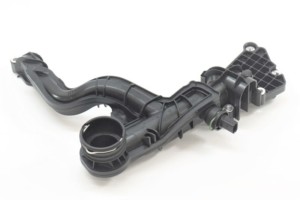 The 2.7L and 3.4L Cayman engine features a plastic coolant pipe that connects the front of the engine to the primary cooling outlet hose. The rubber seals between the plastic part and the engine block degrade to produce a minor coolant leak down the front side of the engine. This part has been updated a number of times by Porsche.
The 2.7L and 3.4L Cayman engine features a plastic coolant pipe that connects the front of the engine to the primary cooling outlet hose. The rubber seals between the plastic part and the engine block degrade to produce a minor coolant leak down the front side of the engine. This part has been updated a number of times by Porsche.
Over-heating - Cracked Cylinder Liner
Symptoms: Engine Overheats and Loss of Coolant
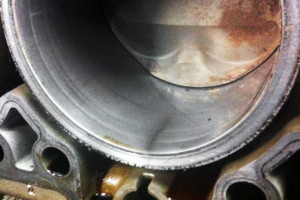 A crack in the cylinder liner of a Cayman engine can show up in a number of ways from coolant consumption, loss of compression to oil consumption. The gradual over-heating of the engine that can occur because of a cylinder liner crack, can take some time to appear.
A crack in the cylinder liner of a Cayman engine can show up in a number of ways from coolant consumption, loss of compression to oil consumption. The gradual over-heating of the engine that can occur because of a cylinder liner crack, can take some time to appear.
In some cases, the engine can run for more than 30 mins before any sign of an issue arises. Typically, at that point, then engine temp will continue to rise despite the cooling fans running. Coolant will also start to disappear from the expansion tank. This can be extremely destructive, although if you have this problem it’s kind of too late.
The only resolution is an engine rebuild with replacement liners or a replacement engine. We’d recommend the advice and guidance of an independent repair shop before making decisions on this repair.
Ignition Switch Failure - No Start - Key Failure
Symptoms: Key Stuck in Ignition or No Start
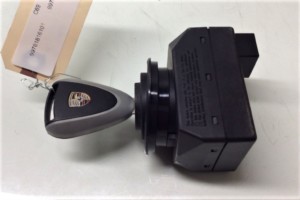
This is a common failure on the Cayman. Turning the key will not start the car or the key has become stuck in the ignition switch.
This problem is typically caused by a failure in the ignition switch mechanism. Replacing the electrical portion of the switch is fairly straight forward and typically solves the no start problem immediately.
Key Failure
The ignition key communicates with the car during the starting procedure. The key includes a small electronic transmitting device that is matched to the car and a small battery to power it. If the key fails to open or lock the doors and will not start the car, replace the battery in the key first, paying particular attention to the orientation of the original battery.
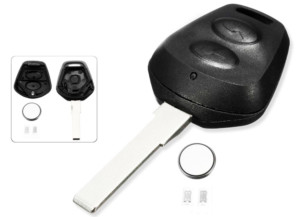 On some occasion it may be necessary to replace the internal electronics of the key or the whole key itself. This can be done by some third party repair shops with the right access to Porsche systems, however, because this is a security device it may be necessary to visit your local dealer.
On some occasion it may be necessary to replace the internal electronics of the key or the whole key itself. This can be done by some third party repair shops with the right access to Porsche systems, however, because this is a security device it may be necessary to visit your local dealer.
Stuck Spark Plugs - Low Mileage Cars
Symptoms: Broken Spark Plug, Misfires, CEL
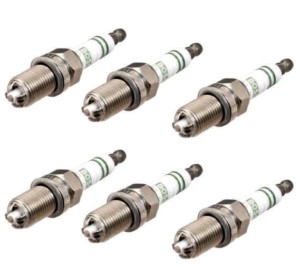
This is a problem that is simple to prevent but often overlooked. Older, low mileage cars regularly still have their original spark plugs. Normal servicing requires the plugs to be changed at 30K mile intervals. However, with many Cayman being used as low mileage weekend cars, the service intervals for the spark plugs are not reached.
Plugs that have been in the engine for more than 10 years can be very difficult, if not impossible, to remove. A stuck or broken plug in the head is an expensive problem to solve and one that can be simply avoided. Check the last time your Cayman had a spark plug change – no harm is done by changing the plugs more often than the recommended 30K interval.
AC System Will Not Cool - Low Refrigerant
Symptoms: Warm Air From AC or Loss of Refrigerant Over Time

If your Cayman AC system blows warm air, the most common issue is a lack of refrigerant. Over time the refrigerant from the AC system will find its way out of the hoses and joints. If, however, you refill the system and sometime later the system is again low on refrigerant, there is clearly a larger than normal leak.
Leaks can occur at any section joint or hose, however, one of the most common and missed places for the leak is at the lower corner of the front condensers.
Debris from leaves and road dirt can build up tucked in the extreme lower corner of the condensers of the Cayman. The debris can hold moisture and degrade the aluminum to point were a hole can appear. This is almost impossible to see or clean out without the bumper being removed.
The refrigerant leak often goes undetected, even to a sniffer, without the debris being cleaned away. Check this thoroughly before making any other assumptions. The AC compressor for example, rarely has issues and a low refrigerant situation can prevent the compressor from engaging.
Exhaust Rattle and Catalytic Converter Inefficiency Faults - CEL
Symptoms: Exhaust Rattle Under Acceleration
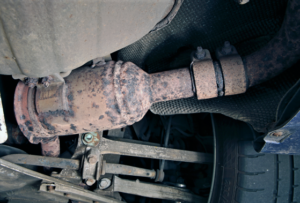 Many Cayman models are starting to experience failure of their catalytic converters and mufflers. In many cases, the main exhaust header pipe leading to the cat converter will crack and fail completely.
Many Cayman models are starting to experience failure of their catalytic converters and mufflers. In many cases, the main exhaust header pipe leading to the cat converter will crack and fail completely.
Initially, you’ll start to notice a rattle back there. This is caused by the muffler, the cat, or both coming apart internally. While annoying, it’s also potentially destructive – a partial blockage in the exhaust can cause the engine to not run or worse, it will cause immense heat to build at the blockage point. Seeing a catalytic converter glowing bright orange under the bumper of a Cayman is quite disconcerting! This has car fire written all over it!
The disintegration of the catalytic converter typically causes a check engine light with emission fault codes associated to converter inefficiency. This means you can’t pass the emissions test and in some states that means not driving the car at all.
The replacement parts from Porsche fall into two categories – 1. ridiculously expensive or 2. not available. The solution is an aftermarket exhaust that fits your budget. See our performance parts for some sensible suggestions to replace the cat or muffler sections on your Cayman. In addition, many repair shops also have imaginative solutions for solving these issues.
Storage Problems - Rodents
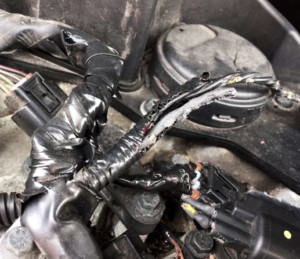
Symptoms: Unusual Electrical Behavior
In some regions, such as the Midwest or Northeast, cars are often stored over the winter months and not driven much until all that nasty white snow stuff disappears. However, the fact that you have your car tucked away in a warm, clean and perfect garage does not mean that its is alone!
Our small rodent friends that we share this planet with, are seeking out the exact environment you have created for your Cayman storage. Small rodents are experts at finding a safe place and hiding beyond your view.
What Looks Good To A Rodent?
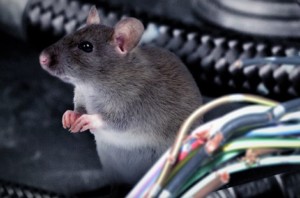 The cabin air filter makes the perfect place for a warm nest – when was the last time you looked in there? Also, the center of the engine, right below the intake, is a perfect place for the safe consumption of food. It’s supplemented by wires that are coated with a plastic made from corn and on cold, long dark winter nights when food is in short supply, that wire seems pretty tasty. Of course, you are blissfully unaware of all of this until the car displays strange engine faults and a musky odor from the air vents!
The cabin air filter makes the perfect place for a warm nest – when was the last time you looked in there? Also, the center of the engine, right below the intake, is a perfect place for the safe consumption of food. It’s supplemented by wires that are coated with a plastic made from corn and on cold, long dark winter nights when food is in short supply, that wire seems pretty tasty. Of course, you are blissfully unaware of all of this until the car displays strange engine faults and a musky odor from the air vents!
On one occasion, we removed a whole mouse family from a Cayman that had eaten the wiring harness, destroyed the carpets, (top stored down) and had eaten most of the cabriolet top.
Take rodent precautions even if you are certain you don’t have that problem.
718 Reported Issues
Reported Issues with Porsche Cayman 718
The Cayman 718 platform is relatively new, with many vehicles still under factory warranty. Sales of the 718 are low (less than 4000 vehicles in 2019), so the number of common problems reported at this stage is low. Mechanical issues that have been reoccurring include the following:
- Noisy or rattling A/C compressor
- Faulty fuel level indicator
- Turbo failure
- PDK Faults
- Noisy PDK downshifts
- Decaying headlights
- Lane Change Assistance Malfunction
Still Can’t Find An Answer? – Contact Us For More Help
If your Cayman has mechanical issues that don’t appear here, simply drop us an email via the forms or pop-up contact and we’ll do our best to share a solution with you.

